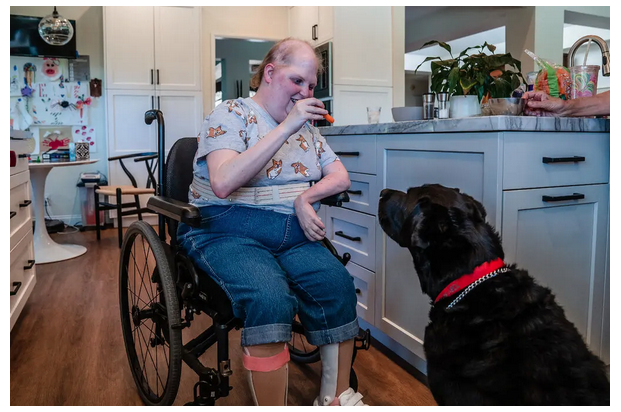by Martha C. White, August 27, 2022, New York Times
People with children who cannot support themselves need to think well past their own lifetime and figure out how to provide for children after they are gone.
Rachel Nagler, 39, has worked part time since she was 22, but she will never be financially independent, according to her father. She is legally blind with a seizure disorder and mild cognitive impairment, the result of birth trauma.
For her parents, Sam and Debra Nagler of Concord, Mass., planning for retirement required them to focus on Rachel’s future as well as their own.
“She has very limited earning capacity,” Mr. Nagler, 70, said. “The concern is, is this sufficient for her for the rest of her life?”
His wife, who is 68, has been their daughter’s primary caregiver since her birth.
“Nobody knows Rachel, and takes care of Rachel, and knows every need of Rachel, and is on top of everything other than my wife,” Mr. Nagler said. “That’s a worry because she’s not going to live forever.”
For parents of children who have serious disabilities or special needs, the challenges of growing and preserving their wealth are magnified exponentially, and the stakes are much higher. While they are trying to plan for their own retirements, these parents need to simultaneously secure the stability of a son or daughter who will be dependent on them until — and even after — their deaths.
“We want to make 100 percent sure that after we’re gone, there’s no issue,” Mr. Nagler said.
Under the best of circumstances, caring for an adult child with special needs is physically and emotionally taxing. As these parents age, the question of who will house, feed and drive their son or daughter after they no longer can becomes an urgent one.
But not all parents in this situation are aware of the myriad challenges they face. “Getting them to understand that they need to think differently about their retirement in this scheme of things is a key step. And it’s not simple,” said Mary Anne Ehlert, a certified financial planner and founder of Protected Tomorrows, a financial planning firm that specializes in families with special needs.
For example, Ms. Ehlert said, she has to consider a multigenerational time horizon for these clients’ portfolios. “We might be a little more conservative, but we still need growth. We need growth longer,” she said. But a conservative-leaning asset mix has drawbacks, too. “Conservative doesn’t always give us the growth we need,” she said. In addition, many families opt for a portion of their portfolio to be in cash or cash-like liquid investments in the event that their child suddenly needs a new piece of expensive equipment, like a speech-assistive device.
Often, one spouse will sideline a career or leave the work force entirely to provide care, reducing their own ability to save for retirement. These families find their budgets strained by a host of ancillary costs: paying for gas to drive their children to therapy appointments and day programs; buying supplies like adult diapers and waterproof bedding, compression tights to promote circulation, specialized diets — the list goes on.
Even when the disabled individual qualifies for public health assistance, finding affordable, adequate housing is especially difficult. Some people require supervised care in a group home, while others need in-home care in a dwelling modified to accommodate physical limitations. In both cases, waiting-list times are measured in years.
As a result, many parents feel they have no choice but to keep their son or daughter at home, said Harry Margolis, an estate planning lawyer near Boston who works with families with special needs. “Often, they’re still living with parents even when everybody’s getting older,” he said.
This can be expensive in terms of lost opportunity costs. To spare their child the upheaval, parents might forgo the opportunity to downsize into a less-expensive or more accessible home while they are still healthy enough to do so.
Since most of the public benefits available to special-needs and disabled people are administered at the state level through Medicaid, parents of a special-needs child might not be able to move to a state with a lower cost of living. Doing so could mean the adult child would lose access to their benefits and be placed at the bottom of waiting lists for services in a new state.
Some families, however, move to states that offer more generous benefits, even if it means a higher cost of living. “That’s a real struggle for these families, particularly as Mom and Dad age,” said Debra Taylor, founder of Taylor Financial Group in Franklin Lakes, N.J. “Some look to relocate to different states because some states are more hospitable than others.”
Hefty costs, and less income
Douglas and Susan Rohrman moved out of the Chicago area five years ago, alarmed at the declining health of their daughter Liz, who suffered a traumatic brain injury just before the age of 2. Now 39, the younger Ms. Rohrman has a host of physical challenges, including partial paralysis that impairs her mobility and ability to swallow and cognitive impairment.
“Liz was not getting great care in Illinois, so it was time to sell the house and move everything,” Ms. Rohrman, 74, said. “I researched this up the wazoo.”
The Rohrmans moved to the San Diego area because resources such as housing and day programs were more readily available. But when Covid struck, the couple felt that the only way they could keep their daughter safe — she had been hospitalized with pneumonia three times in 2019 — was to take her out of the care home they had moved her into just a few years earlier, the one they’d uprooted their lives for.
It was an enormous adjustment in responsibilities, but also in finances.
“When we were doing our taxes, I sort of sat down to see where my money was going. And Liz is a large part of it,” Ms. Rohrman said, ticking off items for which she has to pay out of pocket now that her daughter is living at home.
For example, swallowing difficulties mean that the younger Ms. Rohrman has to have a thickening agent added to her water. That alone costs several thousand dollars a year, her mother said, and there are a host of other unique expenses, such as for stabilizing footwear that helps her daughter walk. “I came up with like $9,000, not counting everything I buy at the grocery store and Walmart,” she said.
Mr. Rohrman, 80, had deferred his retirement at a law firm several years to keep earning income, but he stopped working when the family moved. The combination of much higher expenses, a drop in income and a flagging stock market demanded they re-evaluate their finances.


Liz Rohrman at her family’s home near San Diego. They moved there five years ago, because housing and day programs are more widely available in the area.Credit…Ariana Drehsler for The New York Times.
Unique challenges for single parents
These financial struggles are magnified for single parents. “Care is inevitably more expensive when you have a single parent,” Ms. Taylor said, because they have to rely much more on paid caregivers.
Laura Weinberg, 59, became the sole caregiver for her son Will, who is autistic and nonverbal, when her husband, a lawyer for the Port Authority of New York and New Jersey, was killed in the Sept. 11 attacks.
“I was in the weird situation of being widowed when I was 38, dealing with a 4-year-old who was a danger to himself,” she said. She was also a caregiver for her ailing mother and maintaining the family home in northern New Jersey. “I was overwhelmed,” she said.
“Estate planning was confusing and extremely expensive when I started to put a toe in the water,” she said. “I got all kinds of wrong information.”
Ms. Weinberg said she would like to have speech-assistive equipment for her son so that he can communicate, but the cost is prohibitive. Instead, she has pieced together a solution with an iPad and specialized apps. “It’s more modest than it might have been, but some of them are in the many thousands of dollars,” she said.
Navigating a ‘byzantine’ system
For parents of special-needs children, retirement planning and estate planning have to take place in tandem. Special-needs trusts and life insurance policies in one or both parents’ names are two of the most commonly used tools. Both have to be structured in compliance with the complex eligibility regulations for public health benefits, since many are means-tested.
Mr. Margolis said that even wealthy families have to navigate the byzantine landscape of government benefits, because many of the services available, including housing, are administered entirely through these programs. “In order to qualify for S.S.I. and Medicaid, in most cases you’re limited to $2,000 in countable assets,” he said.
“For a disabled individual, a lot of time, maintaining eligibility is critical,” said Joellen Meckley, executive director of the American College of Financial Services’ center for special needs. “I can’t tell you how many times family members, with the best of intentions, will name a disabled adult child as a beneficiary, not understanding that getting that money could immediately jeopardize their ability to access public benefits,” she said, referring to parents’ wills, retirement plans or life insurance policies.
This makes it imperative that money intended for a disabled individual be held in a specialized financial instrument such as a special-needs trust.
The money in a trust can go toward quality-of-life enhancements for the special-needs individual like cable TV, a cellphone or computer, better food, care providers and rent or utilities, without jeopardizing their public benefits, Mr. Margolis said.
There are two main categories of special-needs trusts. First-party trusts are established with assets that belong to the individual. The drawback is that these trusts have a payback clause: After the individual dies, any money remaining in the trust goes to reimburse the state for the cost of their care over the years.
Third-party special needs trusts are established and funded by someone else for the benefit of the disabled individual. “A third-party one takes in the assets of other people, like gifts, inheritances or life insurance proceeds,” said Brian Walsh, senior manager of financial planning at SoFi.
These trusts are often funded or supplemented with parents’ life insurance proceeds. “A lot of times, life insurance can be used to kind of create a funding source when one or both of them passes away,” Mr. Walsh said.
A “second-to-die” life insurance policy is a frequently used tool. Both members of a couple are covered under it, and the policy pays out after the second spouse dies, providing a more affordable option than insuring each parent separately.
“The purpose of this policy is that it’s going to pay out a death benefit to fund the child’s remaining needs no matter when the parents die,” Mr. Walsh said.
Since the funds in these trusts are generally conservatively invested, experts say the final challenge is making sure that the amount in the trust will provide an adequate income stream.
Getting that balance right is something that the Rohrmans, in California, struggle with.
When Mr. Rohrman stopped working, that meant not only paring back household spending, but revisiting their investing strategy as well.
“We’re financially very conservative. We know we can’t be like we were in our 30s and 40s in terms of our investment mix, spending and so forth,” Mr. Rohrman said. “We think about it a lot. We don’t let it dominate us.”

